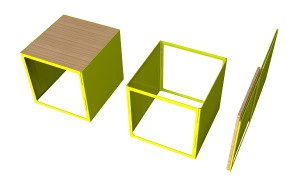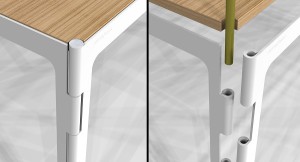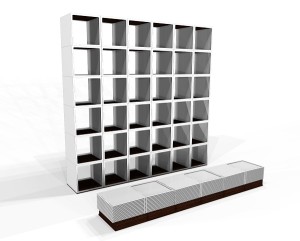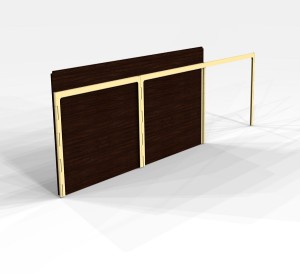
Fully made-in-Italy creative skilfulness and technological know-how can converge into virtuous and surprising designs, able to transform a simple metal sheet into three-dimensional elements of great visual formal impact- With the added value of the patent protection.
Creativity and industry do not always succeed in finding the right balance permitting the highest operational cohesion. Entrepreneurial requirements and extreme uniqueness pursuit do not always allow, in fact, travelling the same road. There are however virtuous examples where this synergy comes true and gives birth to designs, processes and products fruit of a collaboration and of a constructive and effective dialogue. Like in the case of Maurizio Di Bernardo, owner of Mobilferro at Sovico (MB), company specialized in the sheet metal working where are matched experience, craft competence and especially forefront technologies for the machining of metal plates, and Paolo Piuri, architect and lover of design culture. Fertile soil and mix between creativity and industry that have enabled the implementation of an idea. «An idea – confirms Piuri in person – that springs from a mutual professional contamination between design and company, which was the widening of my attention from plastic materials, on which I have worked for a long time, to metal sheets». The almost fortuitous meeting, occurred in 2010, immediately becomes an opportunity of dialogue and development of some concepts, then turned into a patent, for a folding structure usable, for instance, for the furnishing of living spaces, generating a product concept presently called “thinKthin”.

From the idea to the patented system
Starting point of this explorative course was the observation of folding furniture objects, elements that have always been present in our daily life but born in very precise ambits, where transportability and compactness were deemed essential requisites. «There are different examples of folding furnishing articles – specifies Piuri – realized with angular continuous hinges, also in the design ambit, but our idea is based on a small and simple improvement of a known technique that encompasses the meaning of the whole operation, that’s t say to transform the concept into system». In short, the patent issue is the use of a flat stiff element that, introduced into a quadrangular and folding structure, puts a static constraint to hinges, thus stabilizing the object shape. «This base concept – adds Piuri – contains a model of multi-shape utility, that’s to say the possibility of imagining the most different components like tables, seats, cabinets, lighting appliances, furnishings and so on based on the same principle». A patented model, then, protecting a know-how not always taken in due account and to which the deserved importance is not recognized in Italy. «That prospect – underlines Piuri – triggers a short due reflection just about this aspect, the patent protection that, in Italy, at entrepreneurial level, is still scarcely considered an added value. That’s to say how even a single detail, if properly realized and protected, coupled with the time advantage that an idea can give to the enterprise, can become elements that produce innovation and make the product successful».

From the metal sheet to 3D
Creativity, technology and craft propensity have merged in this way into a project where the metal sheet becomes the absolute protagonist, transforming itself into the most different 3D elements. «A mix – states Piuri – also coupled with the will of pursuing a technical sophistication that has then become formal quality, as well as a distinguishing element of the various products: that’s to say to draw hinges directly from the plate that then defines the shape of the object itself rather than fixing continuous strip hinges to the plates». And here is involved the whole production chain, with the capability of “inventing” a method, of crossing machining techniques, of modifying equipment to achieve what had been imagined. «The design target – adds Di Bernardo – is also the possibility of manufacturing sheet metal items that can be shipped in a space slightly exceeding the material mass. Not only, but with an immediate and elementary assembly system that can be carried out also without any manual skill and fastening screws». Rigorous shapes and lines, linear, intentionally minimalist because the angular hinge prevents objects from becoming banal. «Peculiarities, these ones – adds Piuri – influenced also by a reflection in favour of a hypothesis of commercial outlet consistent with the idea that it is possible to channel the project into the by now widespread trend of the e-commerce, modality today deemed mature also for a market like furnishings and furniture one». Absolute quality design objects, then, simple to interpret, rational to ship, easy to mount, distributed with an affordable sale system also for a company without a dedicated sale structure. A business model deemed suitable for medium-small entrepreneurial realities, typical of the Italian productive fabric and not only.

Patent and essential elements of the system
The system patented by the architect Paolo Piuri is based on a folding structure for the implementation of pieces of furniture for living spaces (beds, sofas, chairs, tables, shelves, wardrobes, libraries and lighting appliances) and it essentially includes a kinematic chain and a locking element. The closed kinematic chain encompasses four elements (31, 32, 33, 34) mutually joined by revolute joints in order to form an articulated flat quadrilateral. The said articulated flat quadrilateral defines a first configuration (closed) in which the space enclosed by the four elements (31, 32, 33, 34) is minimal, and a second position (open), in which the spaces delimited by the said four devices is maximum. The locking element, also defined articulated quadrilateral, is inserted in removable manner into the open cavity generated by the above mentioned spatial configuration. With essentially and/or generally plate-like conformation (for instance a square or rectangular plate), the same locking element can be positioned close to the top of the structure (for instance in the table case, as in the example), next to the bottom structure (for instance when dealing with shelves) or at an intermediate height (for instance when chairs are at stake).
Patenting means creating value to the product and to the company
Researches carried out for the “thinkthin” project have highlighted, in particular, that it was already known the implementation of folding structures, made of sheet metal or other materials, with “bellows” opening and closing. Since the inventor was anyway a designer, his target was to propose a more appealing, less expensive and more functional product, and much more. The existing patents consisted in quite similar solutions one another and recalling the “thinkthin” project, but they generally provided for the horizontal or support surface as element in its turn hinged to the remaining structure and made with a soft and deformable material (for instance pieces of cloth). In the “thinkthin” design there is instead a simple quadrangular structure that can be opened like an articulated parallelogram, which, when opened, is locked by a stiff plate element that performs also the function of support surface, or seat. The quadrangular structure is made of sheet metal while the locking plate element can be, advantageously, made with the most varied materials, for instance wood, Corian, crystal or other valuable matters that are typical of the furnishing sector. This has allowed achieving an original concept to create a different product idea, both aesthetical and commercial, with outcomes highly differing from those made possible by the known technique. This method or patent approach to the definition and protection of a technical concept inspires various critical observations and assessments concerning the patent culture in Italy. Various researches carried out on European scale indicate that patents are not considered an important issue by the majority of entrepreneurs. There are some clichés, or perhaps I should say, prejudices that hinder a widespread patent culture. We often believe that to patent is expensive, without considering that the patent cost is negligible in comparison with all the investments needed to develop a product and to engineer it, and without taking into account the potential commercial value of the product. We miss also the capability of understanding that patenting a technology allows increasing the value of the corporate assets (so much so that patents are inscribed on balance sheets as “intangible assets”). Patents can be sold, licensed or pledged. There are then some urban legends, like the one stating that the patent protection is ineffective because “if you just change a screw you are out of the patent”; judgements clearly expressed by people who do not know what they are talking about, but circulating with a certain insistence (as Goebbels said “a lie repeated a hundred times becomes the truth”). Sometimes, some entrepreneurs even consider patents like a problem, while they are a problem for those missing them and, last but not least, some enterprises are neither aware of the fact that what is created in the company might be often validly protected by patent. There is in fact a certain tendency to trivialize the results of one’s own research and development activity and nevertheless, whenever we deal with a new industrial product, we are facing a solution that can be potentially protected by patent. Differently from what often believed, the patent protection is acknowledged also to innovations that may seem “banal”, concerning this we should bear in mind that the inventor tends to evaluate the innovation with the benefit of hindsight, and therefore he can hardly remember the difficulties faced to reach the final technical solution and it is difficult for him to appreciate his effort fully. On the other hand, each technical innovation must also be considered from a commercial point of view. What from a technical perspective may appear like a “a banal modification”, it may be the difference that matters from the commercial point of view. The patent advisor figure can therefore be strategic for the entrepreneur, as the lawyer or the tax advisor. The patent consultant, if informed and involved in the project development, can support the entrepreneur since the early phases of the research and development activity. First of all, he can verify what are the existing patents in a technology, to allow the company to decide whether to invest in that sector or to undertake another course, thus avoiding wasting time and money. Another cliché is represented by the conviction that patents are “things for big-size companies” while instead just small-medium companies should be attentively followed by a patent advisor. Big companies generally rely on a consolidated position on the market, on the contrary small companies, which have small market shares, must invest in the research of new products and new technologies to grow, and must be assisted to protect these investments. It is worth underlining that the patent advisor has not only the task of protecting the results of his investments in research and development, he must also aid the company to protect itself from the most aggressive competitors, which often turn just to the patent instrument to stop those that are trying to enter a mark. A new product generally has a life cycle that includes a development phase, a maturity and an obsolescence phase. The patent owner can also decide, when the patent starts being mature, to license it and to start investing in order to sell more expensive but also more innovative products, then always maintaining an advantage versus its competitors. The patent can also constitute an asset to be put on the scales when two companies clash and afterwards negotiate a settlement; it is important to bear in mind that patents protect not only against competitors but also against “potential competitors “, for instance in case of employees who start up their own activity, patents can be the only instrument to avoid catastrophic damages. An advisor in industrial property aids in protecting not only the technical innovations but also other immaterial assets of the company, for instance brands.



